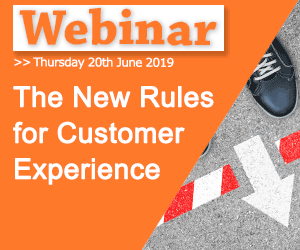Make sure you stay on the right track by following these ten rules to provide good customer service from the contact centre in today’s modern world.
1. Mobile Is the Channel of Choice
For many people the mobile phone is becoming the channel of choice for customer service.
As Martin Hill-Wilson, Founder of Brainfood Extra, explains: “It’s a bit naive to say young people text and older people talk. We are all on a digital journey, but we are all at different stages.”
The lesson here is not to assume that certain people use certain channels. So, when thinking about how you serve customers on certain channels, it is best to revert to brand promises and commitments, as opposed to making decisions based on the age of the majority of users.
While a much greater percentage of the younger generation do prefer to use new channels – such as live chat, social media and even video – one thing is definitely changing: more customers are using mobile phones. We are well past the days of when you expect customers to call from a landline.
In fact, it was 2011 when the number of mobile minutes overtook the number of fixed-line minutes, and the continuing trend is highlighted in the graph below.
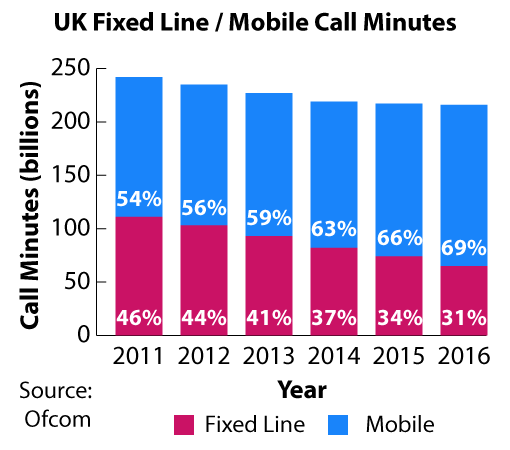
The figures for this graph are based on information from the Ofcom study: Communications Market Report
Most customers, including many of the older generation, will now search your website to find a customer service phone number. So it is more important than ever to ensure that your customer service website is mobile phone friendly and signposts contact details clearly.

In this screenshot (taken from an iPhone 5) of the Topshop customer service website, useful information is hidden in a block of text that’s difficult to read.
Yet, despite more and more people using mobile devices as computers which can offer a number of different contact methods, it’s important not to implement a channel just for the sake of it.
This is a point Martin stresses when he says: “Understanding the balance between what our customers want and our ability to deliver that is a critical thing.”
2. A World-Class Experience Requires a World-Class Team
There is more and more competition for talent in the contact centre and beyond. This is according to Peter Massey, the Managing Director of Budd, who says that: “Attracting the very best people to your organisation is a really vital part of why the best in the world are the best.”
“There are some companies who are in that virtuous circle of talent, where they are creating the right economics and are highly profitable, meaning that they continue to attract the very best people and focus on many different industries.”
“Take Google, for example, they can go into Google Translate, Maps or whatever based on the cashflows from their lead position in analytics and advertising.”
Peter goes on to say that building your own team of people who can achieve such economic success is down to three key questions:
- Are they passionate enough?
- Can they sustain that passion?
- Can you afford it?
Creating a knowledge-sharing, vibrant culture and investment are the two fundamental ways of developing a world-class customer service team.
In the contact centre this means giving advisors the tools that they need and developing a “network-judgement” culture. This is where advisors rely on advice and guidance from colleagues to inform their own decisions.
Find out more about developing this type of culture in our article: What Is the Best Model for Contact Centre Culture?
3. Stop Motivation by Chocolate
“I’m not a fan of motivation by chocolate. You’ve got to make sure that the motivation is intrinsic, otherwise you are doing it for all the wrong reasons.”
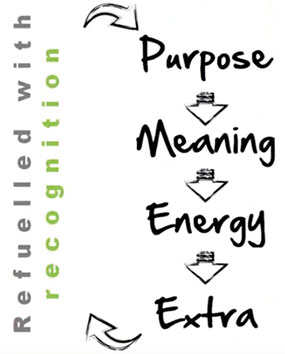
This is the point of Martin Hill-Wilson, who says that one of the greatest challenges of Quality Assurance (QA) is that you’ll never scale it to deal with everybody. You’ll only deal with a very small percentage of contacts on a larger basis, so you have to augment that by ensuring that individuals are personally committed to quality and excellence.
So, instead of handing out incentives for achieving a metric scores, Martin suggests following the psychological loop that is highlighted below.
This model works as the purpose of the business gets the advisor excited and has meaning for them, which releases energy that will help them to go the extra mile. Then, recognition should refuel their desire to be motivated by a purpose once more.
Explaining the loop further, Martin says: “The reason I drew that up together was to highlight that you should never have people in charge with people, who – in their own words – cannot understand that psychology.”
“This brings us to the point that just because you are excellent at something, that doesn’t mean that you should be in charge of people.”
4. The Best Service Is No Service
For some types of business, not requiring service is a stronger proposition than just being good at service, according to Peter Massey. This is very much Amazon’s approach.
Discussing Amazon’s approach, Peter says: “If you look at Amazon’s contacts per unit shipped and compare it to any other retailer, they are orders of magnitudes ahead.”
For some types of business, not requiring service is a stronger proposition than just being good at service.
Peter Massey
The same can be said for Facebook, Google and, to much lesser degree, Apple – as their service journeys have a significantly lower number of unnecessary touchpoints, i.e. moments when the customer interacts with the company but would prefer not to have a problem to deal with.
Nevertheless, some contacts are valued by customers for reassurance. If you can automate processes that are valuable to customers yet irritating for your contact centre, you can build and simplify your self-service journeys to remove customer effort.
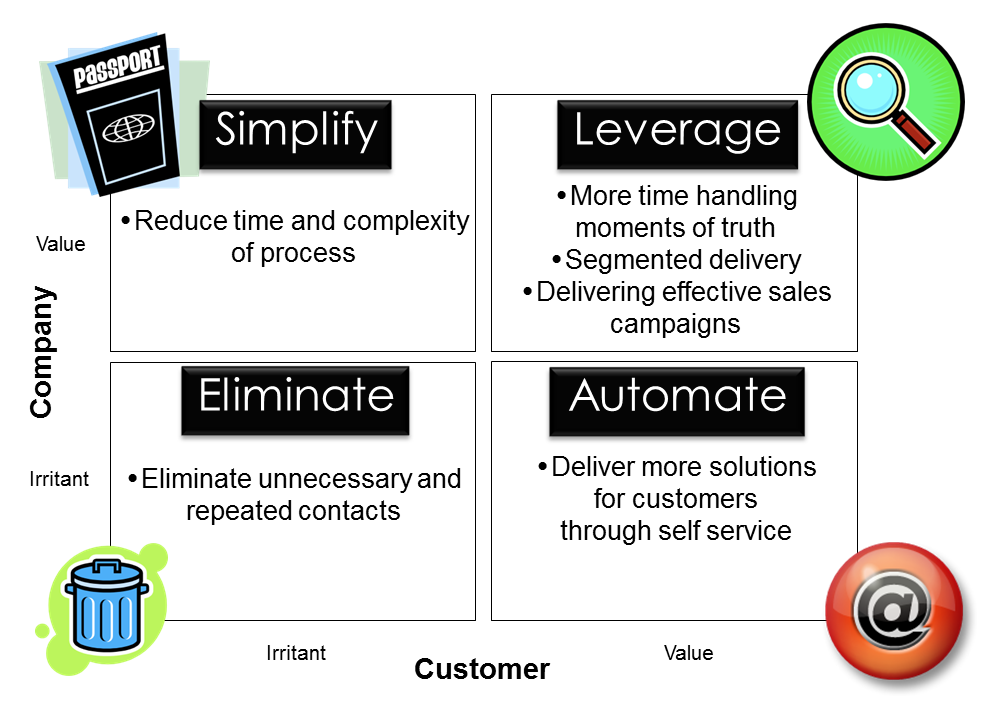
The Value–Irritant Grid is one way of sorting through tasking and deciding what processes are best to automate
For example, it you can introduce self-serve for basic contact reasons, such as password resets, you can focus your staff on areas of higher value to the customers and to you, staying competitive with the major companies in your industry and looking for other ways to better them. This could be by being more proactive or creating more personalised interactions, for instance.
To find out more about the Value–Irritant Grid, read our article: A Simple Technique to Improve Your Contact Centre Strategy
5. Stop Doing Dumb Things to Your Customers
The first thing that many new contact centre managers assess is what dumb things the organisation is doing to its customers. These “dumb things” are contacts which the customer didn’t want and you didn’t want to cause. The type of mistakes that advisors will tell you “happen all the time”, yet it’s a problem that the company has become “numb” to.
Peter Massey gives the example of a “travel insurance company, which sent a customer 12 letters, each of them a £0 bill. Then, when the customer called the contact centre, the advisors would say ‘yeah, that happens all of the time’.”
It is only by holding peer groups to account for causing mistakes like this, which have almost become part of the organisation’s culture, that a contact centre can make serious improvements to the service offerings. The contact centre doesn’t cause the contact, after all. These mistakes, and their root cause ownership, can be identified through proper demand analysis, assessing repeat contact reasons, talking to customers and, most easily, listening to the frontline teams.
The contact centre must also remember to “stop doing dumb things to their employees”. Think about how you might be failing advisors in terms of environment, scheduling and incentives and look to boost morale, which will likely also reduce absenteeism and attrition rates.
6. Anticipate Customer Needs
While the best form of service is no service, the step many consider before that is anticipating what customers want. So, from the customer information that you have, do you know what your customers want? And can you deliver it right now?
Proactivity is becoming a key differentiator in terms of customer service and, as Martin Hill-Wilson says: “If I buy a washing machine, I don’t want to load that pdf and find the instructions on page 59. Can you not anticipate my needs?”
While it is a good step that many companies take, there is much more to proactive customer service than just updating your FAQs page. Some organisations now:
- Send a pop-up live chat message when they notice that customers are having difficulty with their website or completing an order
- Personalise their website – depending on device, behaviours, preferences and even the location of the customer
- Use technology to monitor household products, such as washing machines, to ensure that they stay in good condition
Amazon went one step further than each of these choices, as Martin shares the details of a patent the company has not yet enacted, that Amazon created all the way back in 2012.
Martin says: “Amazon would calculate the sum total of my insights – based on what I’ve bought, what I hovered over, what I’ve put into my wish list etc. – whereby they would know what I would buy from them next. This was to the extent where they would forward-ship that product to a local distribution point.”
7. Start Measuring Customer Emotions
Emotion has a greater impact on customer loyalty than both success and effort.
According to Temkin Group, emotion has a greater impact on customer loyalty than both success and effort. So many organisations are taking a close look at the emotions that they are evoking at each customer touchpoint and assessing how they influence key business targets.
At each of these touchpoints, companies either use sentiment analysis or calculate a metric like the Net Emotional Value (NEV) – as these are the two most common ways of measuring customer emotion. Contact centres can then design each stage of the customer journey with the purpose of eliciting a set of specific emotions.
While many organisations will choose to measure effort, satisfaction or NPS at each touchpoint, as it is easier to do, it is important to remember that these metric scores should be linked to key business outcomes. That is why more and more contact centres are choosing to measure emotion, as it is more closely linked with loyalty and therefore customer lifetime value.
By making the connection between the metrics that you use and business outcomes, you can make a case for further investment. As Martin Hill-Wilson says, “World-class service is underpinned by a commercial insight and belief at the C-level that this is worth cracking.”
8. Quality Must Be Consistent
The customer experience, and every moment of service within that experience, has a whole number of dimensions to it, which makes ensuring quality across all channels difficult.
However, in terms of getting the basics right, there are a number of things that should stay consistent. Martin Hill-Wilson highlights the following five things that should stay consistent:
- Speed – How quickly was the service provided? Are there any opportunities to be more proactive?
- Relevance – How relevant was the response?
- Context – Did you show an understanding of the whole question or respond solely to part of it?
- Personalisation – Was it personalised? (And I don’t mean did we repeat the customer’s name three times!)
- Empathy – Did we show REAL empathy?

Martin Hill-Wilson
Summarising these areas, Martin says: “Consistency is one of the key challenges that everybody faces, yet in many contact centres there is a fallacy of hiding behind averages, but consistency means that everybody gets a good deal.”
The next stage of the process is segmenting your customer base into personas. These “personas” are characters that you create which represent a segment of your customer base. You take each persona and take it through the customer journey, to ensure the experience is consistent for each of your customer types.
To find out more about personas, read our article: 6 Ideas for Customer Journey Mapping
9. Get Your Services Aligned
World-class organisations are not great at everything, but they are consistent across the many moving parts that make world-class service work. These moving parts are difficult to align. This includes linking the service that you provide to your brand promises and commitments.
So, when designing services, one of the first things that brands needs to consider is whether they just need to be better than their competitors or whether they are going to be world-class. To do this, you need to think about your operational model and your business model.
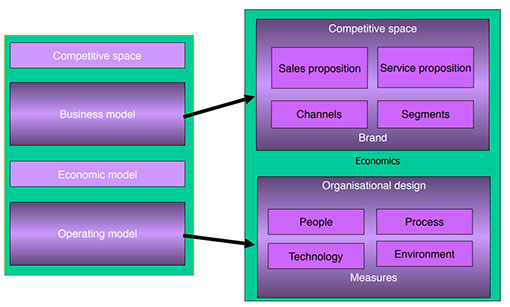
The diagram above was designed by Peter Massey, who says that it’s important to “to think about aligning these different factors and getting clear with your business about what kind of contact centre we want and what do our customers expect.”
Ensuring that marketing material aligns with the experience that is being offered is key, which is something that companies like easyJet do very well.
As Peter says, “easyJet’s planes have easyJet written on the side, so if it’s not easy – in terms of the app, experience at the airport, getting on the plane and so on – it will let them down. So whilst easyJet has absolutely fine but not world-class service, it does what it says on the tin and that for me is really good service.”
So, it seems that when designing services and customer journey maps, it is important to create a set of brand values, promises and commitments which should be “showcased” at each customer touchpoint. These should be considered whenever the business makes any process/product changes.
10. Extend Opening Hours for the Digital Generation
The digital generation have grown up in an era when most things are just a click of a button away. So having to make special arrangements just to be able to contact a company because of their problematic opening times can be irritating.
This point takes us back to the question: do you want to provide a world-class customer service offering? Or do you simply want to be better than your competition?
A modern-day contact centre that provides world-class customer service would likely offer 24-hour service, at least on live chat – a channel which is becoming increasingly popular, especially amongst the younger generation.
But, unfortunately, making the jump to opening channels up for 24/7 service cannot be done on a whim. There are serious impacts to processes, operations and technology that need to be considered.
So, you need to ask yourself a series of questions, which include:
- Do maintenance agreements with your current technology providers cover 24-hour service?
- What are the extra costs? Not only for advisors manning the phones, but also for supervisors, security, people at reception and so on.
- What impact will extending opening hours have on existing staff contracts?
- Does the back office need to be open for longer as well?
- How costly is it to change all marketing material that display your old opening times?
There are likely to be a lot more questions that are added to this list that may influence your decision. This heightens the importance of listening to customer feedback on current opening times, assessing call volumes when you are closed and considering the knock-on effect to other departments, before making a decision.
For more on this topic, read our article: What Are the Best Opening Hours for a Call Centre?
Find more of our insights into how you can deliver good customer service in the contact centre, by reading our articles:
- What Is Exceptional Customer Service?
- 10 Exceptional Customer Service Examples
- What “Going the Extra Mile” REALLY Means in Customer Service
Author: Robyn Coppell
Published On: 20th Jun 2018 - Last modified: 14th Aug 2025
Read more about - Customer Service Strategy, Customer Experience (CX), Customer Journey, Customer Service, Editor's Picks, Martin Hill-Wilson, Peter Massey, Service Strategy








